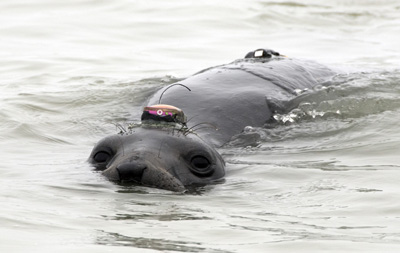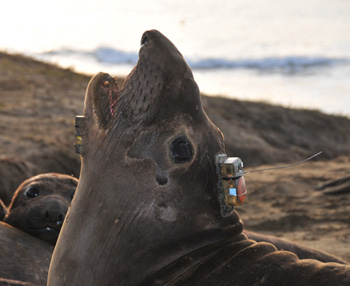Researchers using a new type of tracking device on female elephant seals have discovered that adding body fat helps the seals dive more efficiently by changing their buoyancy.
The study, published November 5 in the Proceedings of the Royal Society B, looked at the swimming efficiency of elephant seals during their feeding dives and how that changed in the course of months-long migrations at sea as the seals put on more fat. The results showed that when elephant seals are neutrally buoyant--meaning they don't float up or sink down in the water--they spend less energy swimming and are able to maximize the time spent feeding during dives.
"The ideal is to be neutrally buoyant, and when you move away from that in either direction there's a cost," said coauthor Daniel Costa, professor of ecology and evolutionary biology and leader of the elephant seal research group at UC Santa Cruz.
Elephant seals fast during their time onshore, burning the fat stored up during months at sea feeding on fish. A female nursing a pup can lose 30 to 40 percent of her body weight. When she heads back out to sea, she is negatively buoyant, meaning she can sink into deep water without swimming very hard. This makes it easy to dive to the great depths at which elephant seals feed (routinely 1,000 to 2,000 feet or more), but coming back up to the surface takes a lot of effort.
"It's like a scuba diver wearing a weight belt--getting down is easier, but you have to swim hard to come back up," Costa said.
Stroke Logger
Using a new tag with built-in accelerometers, called a Stroke Logger, the researchers were able to record the number of strokes made by a swimming seal with its hind flippers. The number of strokes per meter provided a measure of the energy cost of swimming. As the migration progressed and the seals put on more fat, the strokes per meter during the descent phase of each dive increased while strokes per meter during the ascent decreased. But the total number of strokes needed to complete a round-trip gradually declined as the seals put on more fat, reaching its lowest point when the seals achieved neutral buoyancy.
The results also showed that as the seals reached neutral buoyancy they spent more time at the bottom of their dives. Previous studies by Costa's team, using accelerometers to record jaw movements, showed that elephant seals do most of their feeding at the bottom of a dive, not during the descent or ascent.
By the end of a long feeding migration, a pregnant female elephant seal may be positively buoyant, making it easier to ascend but harder to descend. Again, the deviation from neutral buoyancy leads to an increase in the number of strokes needed for a round-trip and a decrease in time spent at the bottom of a dive.
"At neutral buoyancy, they're able to spend more time foraging at depth because they're spending less energy moving up and down," Costa said. "We've known for years that elephant seals gain a lot of fat when they're at sea, and we've always looked at it in terms of the advantages of laying down fat to deal with periods of fasting. But we hadn't thought much about how it affects their diving."
Superweaners
Costa said the findings might explain why "superweaner" pups, which grow twice as big as other pups by nursing from multiple females, are rarely seen again after they leave the rookery. "Their brain tells them to get as fat as possible because they have to feed themselves when they go out to sea, but these guys are probably so buoyant that it's hard for them to figure out how to feed. We almost never see them again," he said.
UC Santa Cruz researchers have been tracking the migrations and diving behavior of northern elephant seals since the 1980s, using tags that have steadily increased in sophistication over the years. Many of those tags, including the stroke loggers used in the new study, were developed by researchers at Japan's National Institute of Polar Research. First author Taiki Adachi, a graduate student at the Graduate University for Advanced Studies in Tokyo, spent the past four field seasons working with Costa's group at the elephant seal rookery at Año Nuevo State Reserve.
"This is another nice result from our long-term collaboration with the Japanese research team," Costa said.
In addition to Adachi and Costa, the coauthors of the paper include Jennifer Maresh, Patrick Robinson, and Sarah Peterson at UC Santa Cruz, and Yasuhiko Naito, Yuuki Watanabe, and Akinori Takahashi at the National Institute of Polar Research. This research was supported by the Japan Society for the Promotion of Science and the U.S. Office of Naval Research.




